| |
Despite the mental image of Kansas as a vast, flat landscape, rivers such as the Smoky Hill
cut deeply through the sediments laid down by a once vibrant marine environment. The Western
Interior Seaway (Inland Sea) covered much of North America for millions of years, until finally
retreating for good, near the end of the Cretaceous, 65 million years ago.
The Smoky Hill Chalk of western Kansas provides well preserved reminders of the area's past.
The disassociated material so common on the East Coast is present, but articulated material is also
common. Whether it's a "fish-in-a-fish", slain mosasaur or the crumpled remains of what was once a
graceful pteranodon, the chalk provides much more than an isolated tooth.
STRATIGRAPHY AND DEPOSITIONAL ENVIRONMENT
The width and depth of the inland seaway changed relatively frequently, responding to plate tectonics
and fluctuating sea levels. The depositional environment also changed in response to the distance to
shorelines, climate changes (increased rainfall, etc) and the influx of erosional sediments. Water
circulation in the central and northern portions of the seaway was generally poor and the water may
have been stratified from time to time, leading to anoxic bottom conditions. These changing conditions
certainly affected the distribution of many species of marine life. The number of shark species, in
particular, seems somewhat limited when compared to the Cretaceous marine exposures of Texas
and the East Coast.
Cretaceous marine deposits in Kansas overlie the Late Jurassic Morrison formation. The Kiowa Formation
is the lowest member of the group, consisting of shales, mudstones and sandstones deposited during the
Kiowa-Skull Creek cyclothem. (A cyclothem is a geologic term for periods when alternating layers of
marine and terrestrial sediments were laid down as the seas retreated and advanced)
According to Stewart (1990b), sharks include: Hybodus sp., Scapanorhynchus sp., Lamna sp.,
and Scyliorhinus sp. The Dakota formation (Middle Cenomanian, 15+ meters thick) is found in the
central portion of the state and consists of sandstones, siltstones, mudstones and shales from
non-marine and marginal marine sediments deposited in the early portion of the Greenhorn cyclothem.
The Graneros Shale (late Middle Cenomanian, about 9 meters thick) consists of shales, sandstones
and limestones deposited as marine sediments in deeper water during the early part of the Greenhorn
cyclothem. Ptychodus occidentalis is found in this formation. The Greenhorn Limestone (Upper
Cenomanian through lower Turonian, about 30 meters thick) consists of shaley chalks and chalky
limestones deposited during the maximum transgression of the Greenhorn cyclothem.
The Carlile Shale
The Carlile Shale (Middle Turonian, about 84 meters thick) is made up of shales, shaley chalks
and chalky limestones deposited during the regression of the Greenhorn cyclothem. Stewart (1990b)
reported Cretalamna appendiculata, Cretodus crassidens, Cretoxyrhina mantelli, Squalicorax falcatus
and Ptychodus whipplei from this formation. Russell (1993) does not include P. whipplei,
however, and adds Ptychodus mammilaris to Stewart's list.
The Niobrara Formation
The Niobrara consists of chalky limestones (Fort Hays Limestone, Lower through middle Coniacian,
about 20 meters thick) and chalks (Smoky Hill Chalk, upper Coniacian through lower Campanian,
about 180 meters thick) deposited in the middle of the seaway during the maximum transgression
(advance) of the Niobrara cyclothem.
Shark teeth and other vertebrate fossils are rare in the Fort Hays Limestone. Shimada (1996) lists
Scapanorhynchus sp., Cretalamna appendiculata, Paranomotodon sp., Squalicorax falcatus,
Cretoxyrhina mantelli and Ptychodus mortoni.
The Smoky Hill chalk represents a completely different depositional environment and sharks'
teeth are more commonly found. Stewart (1990) lists the following species from the Smoky Hill chalk:
Squalicorax falcatus, Squalicorax sp. aff. kaupi, Scapanorhynchus raphiodon, Psuedocorax laevis,
Cretoxyrhina mantelli, Cretalamna appendiculata, Rhinobatos incertus, Ptychodus mortoni,
P. martini and P. anonymous. Stewart (1990) also suggests that small enterospirae (coprolites) found
only in the lower chalk suggest that an unknown species of shark was also present. In 1998, the
teeth of an undescribed species of paleoanacoracid shark were was discovered in the lower
chalk (Mikael Siverson, personal communication) and will be published in the near future.
Individual shark teeth are a fairly common find in the Smoky Hill chalk. When they weather out
of the softer chalk, most sharks teeth are in pristine condition and require little or no preparation besides
washing in plain water. They do, however, deteriorate rapidly when exposed to weathering.
Finding a large, nearly perfect sharks tooth with its shiny, brownish-grey enamel weathered to
a pasty white, brittle layer is really disappointing.
Compete and articulated dentitions have been found for Squalicorax, Cretoxyrhina and three
species of Ptychodus. Isolated vertebrae and calcified fin elements are also found occasionally
in the Smoky Hill chalk. Evidence of predation / scavenging by sharks (bite marks, severed bones
and embedded teeth) has been found on nearly all species of marine reptiles and the remains
of most large fish.
The Pierre Shale
The Pierre Shale (Middle through Upper Campanian, about 100 meters thick) consists of dark gray
shales deposited during the regression (retreat) of the Niobrara cyclothem. The lowest (Sharon
Springs) member of the Pierre Shale lie conformably on the top of the Smoky Hill chalk. While this
member is quite fossiliferous, sharks are poorly represented. Teeth and vertebrae of
Squalicorax sp. are known from the Pierre Shale.
CHONDRICHTHYAN FAUNA
| | |
| CLICK ON IMAGES FOR ADDITIONAL DETAILS
|
| HYBODONTIFORMES |
|
|
|
IMAGE
REQUIRED |
Ptychodus whipplei MARCOU, 1858 - extinct family
This species has bee reported from the Carlile Shale (Middle Turonian) |
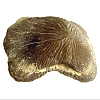 |
Ptychodus mortoni AGASSIZ, 1839 - extinct family
The high crowned teeth of P. mortoni is by far the most common Kansas ptychodid. It is known from Fort Hays Limestone (lower through middle Coniacian) and in the lower 1/3 of the Smoky Hill Chalk (latest Coniacian). |
 |
Ptychodus martini WILLISTON, 1898 - extinct family
Although the teeth of this species are rare, two dentitions have been found. The low-cusped
teeth of P. martini appear to be relegated to lower 1/4 of the Smoky Hill Chalk (Coniacian). |
 |
Ptychodus anonymus WILLISTON, 1900 - extinct family
The teeth of this species are less common than those of P. mortoni and are known from
lower Smoky Hill Chalk (Coniacian) exposures. The crown of these teeth are moderately inflated. |
| LAMNIFORMES |
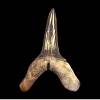 |
Scapanorhynchus raphiodon (AGASSIZ, 1844) - goblin shark
Scapanorhynchus. sp. has been reported from the Fort Hays Limestone and
S. raphiodon from the Smoky Hill Chalk (upper Coniacian through lower Campanian). |
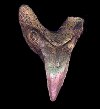 |
Cretodus crassidens (DIXON, 1850) - extinct lamnoid
In Kansas, Cretodus teeth have only been reported from the Carlile Shale (Middle Turonian |
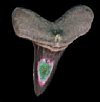 |
Cretoxyrhina mantelli (AGASSIZ, 1843) - extinct mako-like shark
Found in Carlile Shale, Fort Hays Limestone and Smoky Hill Chalk, (upper Coniacian through lower Campanian)
sediments, the teeth of C. mantelli reached it's greatest size and abundance in the lower one third
(late Coniacian) of the chalk. |
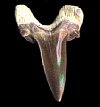 |
Cretalamna appendiculata (AGASSIZ, 1843) - extinct makeral shark
This species is represented in faunas from the Carlile Shale, Fort Hays Limestone and Smoky Hill Chalk,
where they are a relatively rare find. |
 |
Squalicorax cf falcatus (AGASSIZ, 1843) - crow shark
Teeth of this species have been ascribed to the Carlile Shale, Fort Hays Limestone
and through out the Smoky Hill Chalk.They tend to increase in size from the bottom to the top in the chalk. |
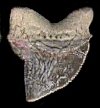 |
Squalicorax kaupi (AGASSIZ, 1843) - crow shark
Larger than those of Squalicorax falcatus those of S. sp. aff. kaupi are found only
in the upper quarter of the Smoky Hill Chalk, (early Campanian). |
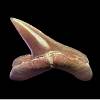 |
Pseudocorax aff. granti CAPPETTA & CASE 1975 - extinct lamnoid shark
These teeth are rare and known from Santonian sediments.
P. laevis (LERICHE, 1906) has also been reported as present in upper Coniacian through lower Campanian sediments. |
 |
Paranomotodon sp - extinct thresher shark
Teeth from this species have been reported from the Fort Hays Limestone (lower through middle Coniacian)
only. |
| RAJIFORMES |
IMAGE
REQUIRED |
Rhinobatos incertus - guitarfish
Rhinobatos teeth have been reported from the Smoky Hill Chalk |
SITE SPECIFIC REFERENCES
Russell, Dale A., 1993. Vertebrates in the Western Interior Sea, in Caldwell, W.G.E.
and Kaufmann, E.G. eds, Evolution of the Western Interior Basin, Geological Association of
Canada, Special Paper 39, pp. 665-680
Shimada, Kenshu, 1996. Selachians from the Fort Hays Limestone Member of the Niobrara Chalk
(Upper Cretaceous), Ellis County, Kansas, Trans. Kansas Academy of Science, 99(1-2). pp. 1-15
Shimada, Kenshu, 1997. Shark-Tooth-Bearing Coprolite from the Carlile Shale (Upper Cretaceous),
Ellis County, Kansas, Trans. Kansas Academy of Science, 100(3-4). pp. 133-138
Stewart, J.D., 1990a. Niobrara Formation Vertebrate Stratigraphy, in Niobrara Chalk Excursion
Guidebook, S. C. Bennett, Editor, The University of Kansas Museum of Natural History and the
Kansas Geological Survey, pp 19-30. (for the 1990 SVP meeting, unpublished)
Stewart, J.D., Bennett, S. Christopher, and Zakrzewski, Richard J., 1990b. Road Log from Lawrence
to the type area of the Niobrara Chalk, October 9-10, 1990, in Niobrara Chalk Excursion Guidebook,
S. C. Bennett, Editor, The University of Kansas Museum of Natural History and the Kansas Geological
Survey, pp 19-30. (for the 1990 SVP meeting, unpublished)
Be sure to visit the Oceans of Kansas
website for additional information on Kansas and the chalk.
If you can provide feedback or help us with this effort, contact:
Mike Everhart or
Jim Bourdon
|